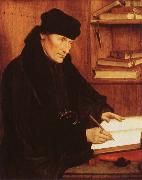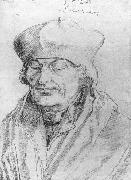
|
Quentin Massys
|
|||
|
|
|||
| 1464-1530 Flemish Quentin Massys Galleries Quentin Matsys, his first name also recorded as Quinten or Kwinten and his last name as Massys, Metsys, or Matsijs (1466 - 1530), was a painter in the Flemish tradition and a founder of the Antwerp school. He was born at Leuven, where he was trained as an ironsmith. Near the front of the Cathedral of Our Lady in Antwerp is a wrought-iron well, known as the "Matsys Well," which according to tradition was made by the painter-to-be. During the greater part of the 15th century, the centres in which the painters of the Low Countries most congregated were Tournai, Bruges, Ghent and Brussels. Leuven gained prominence toward the close of this period, employing workmen from all of the crafts. Not until the beginning of the 16th century did Antwerp take the lead which it afterward maintained against Bruges, Ghent, Brussels, Mechelen and Leuven. Matsys, as a member of Antwerp's Guild of Saint Luke, was one of its first notable artists. A legend relates how Matsys, while a smith in Leuven, fell in love with the daughter of a painter; by changing his trade to painting, he hoped that she would love him in return. Less poetic but perhaps more likely is another version of the story: Quentin's father, Josse Matsys, was clockmaker and architect to the municipality of Leuven. The question arose as to which of his sons, Quentin or Josse, should follow in this lucrative business. Josse the son elected to succeed the father. Quentin then took up the study of painting. We are not told expressly by whom Matsys was taught, but his style seems to have derived from the lessons of Dirk Bouts, who brought to Leuven the influence of Memling and van der Weyden. When Matsys settled at Antwerp at the age of twenty-five, his own style contributed importantly to reviving Flemish art along the lines of van Eyck and van der Weyden. What characterizes Matsys in particular is a strong religious feeling, an inheritance from earlier schools. This feeling was permeated by a realism which often favored the grotesque. The faces of the boors of Steen or Ostade may well have had predecessors in the pictures of Matsys, though he was not inclined to use them in the same homely way. From the example of van der Weyden comes Matsys' firmness of outline, clear modelling and thorough finish of detail; from the van Eycks and Memling by way of Dirck Bouts, the glowing richness of transparent pigments. The date of his departure from Leuven is 1491, when he became a master in the guild of painters at Antwerp. His most celebrated picture was executed in 1508 for the joiners' company in the cathedral of his adopted city. Next in importance is the Marys of Scripture round the Virgin and Child, ordered for a chapel in the cathedral of Leuven. Both altarpieces are now in public museums, one at Antwerp and the other at Brussels. They display an earnestness in expression, a minuteness of rendering, and subdued effects of light or shade. Matsys, like the early Flemish painters, lavishes care on jewelry, edgings of garments, and ornament in general. The Moneylender and his Wife (1514) Oil on panel, 71 x 68 cm Mus??e du Louvre, ParisNot much given to atmosphere, his paintings sometimes rely on the literalness of caricature: emphasizing the melancholy refinement of saints, the brutal gestures and grimaces of gaolers and executioners. Strenuous effort is devoted to the expression of individual character. A satirical tendency may be seen in the pictures of merchant bankers (Louvre and Windsor), revealing their greed and avarice. His other impulse, dwelling on the feelings of tenderness, may be noted in two replicas of the Virgin and Child at Berlin and Amsterdam, where the ecstatic kiss of the mother seems rather awkward. An expression of acute despair may be seen in a Lucretia in the museum at Vienna. The remarkable glow of the colour in these works, however, makes the Mannerist exaggerations palatable. But on the whole, the best pictures of Matsys are the quietest. His Virgin and Christ, Ecce Homo and Mater Dolorosa (London and Antwerp) display a serene and dignified mastery, gaining in delicacy and nuance in the works of his maturity. It is believed that he may have known the work of Leonardo da Vinci in the form of prints made and circulated among northern artists. Matsys had considerable skill as a portrait painter. His Ægidius (Peter Gilles) which drew from Thomas More a eulogy in Latin verse, is but one of many, to which one may add the portrait of Maximilian of Austria in the gallery of Amsterdam. In this branch of his practice, Matsys was greatly influenced by his contemporaries Lucas van Leyden and Jan Mabuse. In his rendering of polished detail, he may lack the subtle modelling of Holbein and D??rer. There is reason, however, to think him well acquainted with these German masters. He probably met Holbein more than once on his way to England. D??rer visited his house at Antwerp in 1520. Matsys also became the guardian of Joachim Patinir's children after the death of that painter, who is believed to have worked on some of the landscapes in Matsys' pictures. Matsys died at Antwerp in 1530. That rigor of religious feeling, which could be said to have slumbered in him, was eventually fatal to some of his relatives. His sister Catherine and her husband suffered at Leuven in 1543 for what was then the capital offence of reading the Bible: he being decapitated, she buried alive in the square before the cathedral. His works include A Portrait of an Elderly Man (1513), The Money Changer and His Wife (1514), and The Ugly Duchess (1515). The Ugly Duchess is perhaps the best-known of his works. It served as a basis for John Tenniel's depiction of the Duchess in Alice's Adventures in Wonderland. It is likely a depiction of a real person with Paget's disease[1], though it is sometimes said to be a portrait of Margaret, countess of Tyrol, also known as Margarete Maultasch ("Satchel-mouth"). Quentin's son, Jan Matsys, inherited the art but not the skill of his father. The earliest of his works, a St Jerome dated 1537, in the gallery of Vienna, as well as the latest, a Healing of Tobias of 1564, in the museum of Antwerp, are evidence of his tendency to substitute imitation for originality. Another son, Cornelis Matsys, was also a painter. Jan's son, Quentin Metsys the Younger, was an artist of the Tudor court, and painted the Seive Portrait of Elizabeth I of England. | |||
|
|
|||
|
Portrait of Erasmus new4/Quentin Massys-748634.jpg Painting ID:: 30477 |
mk68 Oil on wood Transferred to canvas National Gallery of Art of the Past 1517 Netherlands | ||
|
|
|||
|
Albrecht Durer
|
|||
|
|
|||
| b.May 21, 1471, Imperial Free City of Nernberg [Germany] d.April 6, 1528, Nernberg Albrecht Durer (May 21, 1471 ?C April 6, 1528) was a German painter, printmaker and theorist from Nuremberg. His still-famous works include the Apocalypse woodcuts, Knight, Death, and the Devil (1513), Saint Jerome in his Study (1514) and Melencolia I (1514), which has been the subject of extensive analysis and interpretation. His watercolours mark him as one of the first European landscape artists, while his ambitious woodcuts revolutionized the potential of that medium. D??rer introduction of classical motifs into Northern art, through his knowledge of Italian artists and German humanists, have secured his reputation as one of the most important figures of the Northern Renaissance. This is reinforced by his theoretical treatise which involve principles of mathematics, perspective and ideal proportions. His prints established his reputation across Europe when he was still in his twenties, and he has been conventionally regarded as the greatest artist of the Renaissance in Northern Europe ever since. | |||
|
|
|||
|
Portrait of Erasmus new21/Albrecht Durer-593798.jpg Painting ID:: 63597 |
1520 Charcoal on paper, 37 x 27 cm Mus?e du Louvre, Paris In Brussels D?rer met Erasmus, the humanist scholar, and sketched his portrait which six years later he would use as the basis for an engraving. Born in Rotterdam in 1469, Desiderius Erasmus was the greatest European scholar of the 16th century. Using the philological methods pioneered by Italian humanists, he helped lay the groundwork for the historical-critical study of the past, especially in his studies of the Greek New Testament and the Church Fathers. His educational writings contributed to the replacement of the older scholastic curriculum by the new humanist emphasis on the classics. By criticizing ecclesiastical abuses, while pointing to a better age in the distant past, he encouraged the growing urge for reform, which found expression both in the Protestant Reformation and in the Catholic Counter-Reformation. Finally, his independent stance in an age of fierce confessional controversy - rejecting both Luther's doctrine of predestination and the powers that were claimed for the papacy - made him a target of suspicion for loyal partisans on both sides and a beacon for those who valued liberty more than orthodoxy.Artist:D?RER, Albrecht Title: Portrait of Erasmus Painted in 1501-1550 , German - - graphics : portrait | ||
|
|
|||
|
Also Buy::. For Following Paintings / Artists / Products, Please Use Our Search Online: |









